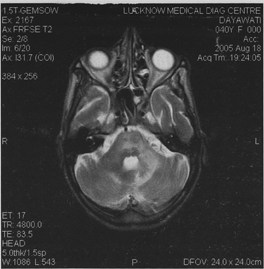Annals of Neurosciences, Vol 13, No 4 (2006)
Annals of Neurosciences, Volume 13, Issue 4 (October), 2006
MYOCLONIC ATAXIA AS PRESENTING MANIFESTATION OF HIV INFECTION
Corresponding author
Prof. Rakesh Shukla
Department of Neurology
King George's Medical University, Lucknow-226003
Abstract
The progressive myoclonic ataxias are a heterogeneous group of rare conditions causing the clinical triad of progressive ataxia and severe myoclonus, mild epilepsy, and cognitive changes. A case of progressive myoclonic ataxia in an AIDS patient is described.
Keywords: Progressive multifocal leucoencephalopathy, Myoclonic ataxia, HIV.
Introduction
Patients with HIV infection may develop hyperkinetic or hypokinetic movement disorders such as hemichorea-ballismus, myoclonus, dystonia, tremor, and ataxia (1). Recognizing the movement disorder is important because it may be the presenting manifestation of HIV infection or may result from an opportunistic infections in the brain.
Here we report a AIDS patient who presented with clinical triad of myoclonic ataxia, epilepsy and cognitive changes.
Case report
40 years old female presented to us with history of intermittent low-grade fever, diarrohoea and weight loss for past two years. For last six months she had mild frontal headache, abnormal behaviour in the form of occasional outburst of temper, increased religiousness and visual hallucinations. She had abnormal movements in the form of tremulousness which started in the left upper limb, involved whole body including head and tongue within a span of fifteen days. Movements used to increase following tactile stimulation and tend to disappear during sleep. There were two episodes of right focal seizures with secondary generalization during hospital stay. There was no history of vomiting, bulbar symptoms, sensory disturbances or sphincter dysfunction. Previous history of recurrent abortion was present. No prior history of blood transfusion or surgical interventions was there.
On general examination she was malnourished, having pallor and oral candidiasis. Her vitals were stable. Although she was conscious, detailed higher mental function evaluation was not possible due to poor attention span. She had upgaze restriction with left lateral rectus palsy. Pupils and fundi were normal. On motor system examination, she had generalized wasting, grade one spasticity, normal muscle strength, normal jerks with extensor planter response. Abnormal involuntary arrhythmic movements were present in all four limbs, which used to increase following loud noise and tactile stimulation. Similar movements were also observed in head, tongue and soft palate. She had bilateral cerebellar signs more prominent on left side.

Figure 1: T2 Weighted axial image showing hyperintense signal intensities in brain stem, middle cerebellar peduncle and cerebellum

Figure 2: Contrast enhanced Tl weighted axial image showing non-contrast enhancing hypointense lesion involving middle cerebellar peduncle
In laboratory evaluation, hemogram revealed low hemoglobin value (9.0 gm%) with normal leucocyte count. Serum electrolytes, liver function test, renal function tests and chest X ray were within normal limits. HIV ELISA was reactive from two different laboratories. Her CD4 count was 59/cumm. CSF examination revealed lymphocytic pleocytosis (90 cells, L70 P30) with increased protein and normal sugar and lactate levels. Antinuclear antibody was weakly positive however antitardiolipin antibody, VDRL were negative. Computed tomographic scan showed hypodense lesion in left cerebellum. Magnetic resonance imaging revealed hypointense lesion in left cerebellum, and middle cerebellar peduncle on T1 weighted images. T2 weighted images revealed hyperintense lesions in the white matter near right occipital horn, cerebellum, middle cerebellar peduncle and midbrain. Diffusion weighted images did not show restriction and lesions were nonenhancing on contrast study.
Discussion
Clinically relevant movement disorders are identified in 3% of patients with HIV infection in hospital based studies (2). Various movement disorders have been described in HIV patients like dystonia, chorea, hemiballismus, tics, paroxysmal dyskinesias and myoclonic ataxia (1).
The progressive myoclonic ataxias are a heterogeneous group of rare conditions causing the clinical triad of progressive ataxia and severe myoclonus, mild epilepsy, and cognitive changes (3). Possible aetiologies are mitochondrial encephalomyopathies, storage disorders, some progressive neurodegenerative diseases, paraneoplastic syndromes, viral encephalitis, HIV encephalopathy and opportunistic infections.
Up to our best knowledge there is only one case report of progressive myoclonic ataxia in AIDS patient. Here we report a case having clinical triad of progressive myoclonic ataxia, who on investigations turned out to be HIV positive Few clinicopathological studies of progressive myoclonic ataxia to date, have pointed to preferential involvement of regulatory neocerebellar pathways between the cerebellum, red nucleus, thalamus, and motor cortex (3). In our case, we believe that the initial selective involvement of structures in the mollaret's triangle, as documented by neuroimaging, was responsible for the progressive ataxia and palatal tremor.
Myoclonic ataxia in HIV infection can be caused by HIV encephalopathy, vasculitis and opportunistic infections like toxoplasmosis and JC virus (4,5). Clinical profile and neuroimaging studies were consistent with progressive multifocal leukoencephalopthy, most probable aetiology in our case may be JC virus.
Patient was put on HAART consisting of two NRTI (zidovudine and lamivudine) and protease inhibitor (indinavir and seqvinavir) along with clonazepam and valproate. Patient had some symptomatic improvement at 1 month follow up.
This case gives us a lesion that HIV should be ruled out in any young patient presenting with atypical movement disorder.
Reference:
1. Mirsattari SM, Roke Berry ME, Holden JK . Paroxysmal dyskinesias in patients with HIV infection, Neurology, 1999; 52 : 109.
2. Cardoso F. HIV related movement disorders: epidemiology, pathogenesis and management. CNS Drugs. 2002; 16 : 663–8.
3. Fontoura P, Vale J, Lima C, Scaravilli F, Guimarães J. Progressive myoclonic ataxia and JC virus encephalitis in an AIDS patient J Neurol Neurosurg Psychiatry, 2002; 72 : 653 – 656.
4. Marsden CD, Harding AE, Obeso JA, et al. Progressive myoclonic ataxia (the Ramsay Hunt syndrome) Arch Neurol 1990;47:1121–5.
5. Nath A, Jankovic J, Pettigrew LC. Movement disorders and AIDS. Neurology 1987;37:37–41.